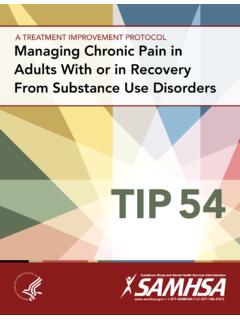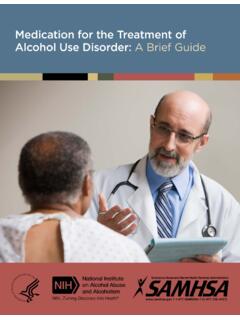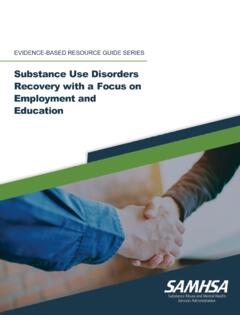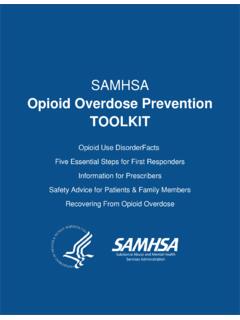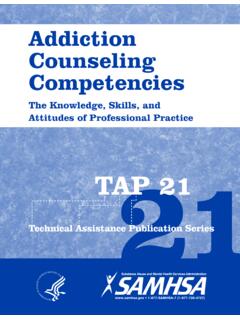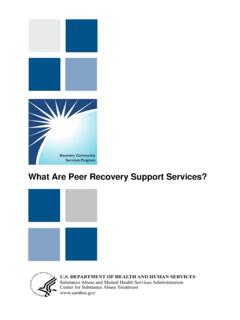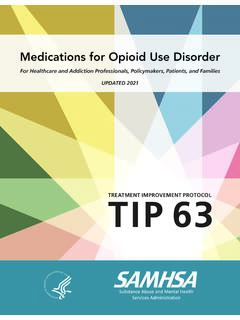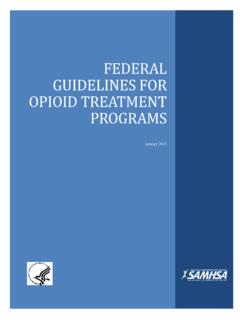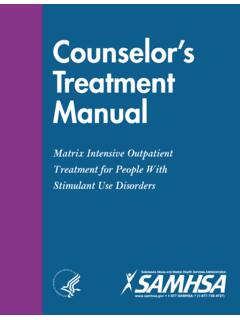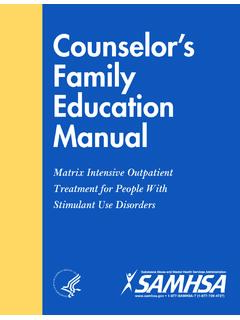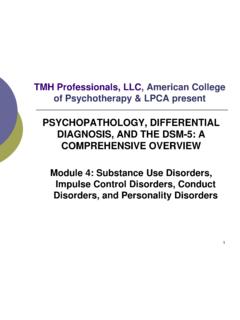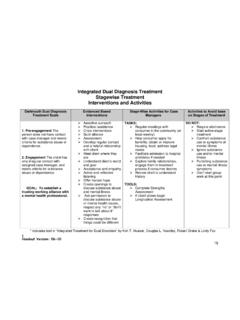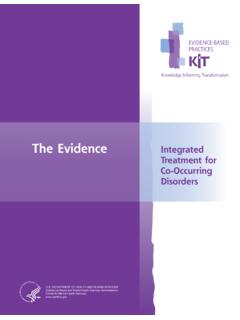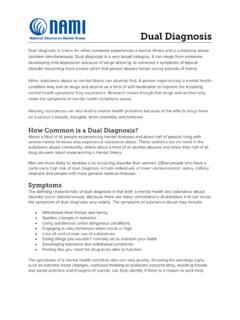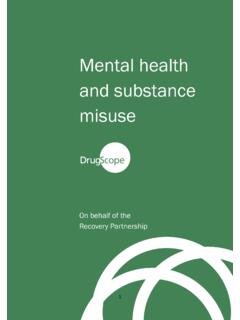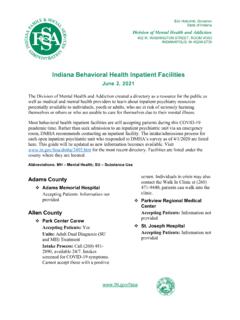Transcription of Substance Use Disorder Treatment for People With Co ...
1 Substance Use Disorder Treatment for People With Co-Occurring Disorders UPDATED 2020 Treatment IMPROVEMENT PROTOCOL TIP 42 This page intentionally left 42 Please share your thoughts about this publication by completing a brief online survey at: The survey takes about 7 minutes to complete and is anonymous. Your feedback will help SAMHSA develop future products. i This page intentionally left 42 Contents Foreword vii Executive Summary ix Overall Key Messages ix Content Overview x Consensus Panel xvii TIP Development Participants xvii KAP Expert Panel and Federal Government Participants xviii Publication Information
2 Xxvii Chapter 1 Introduction to Substance Use Disorder Treatment for People With Co-Occurring Disorders 1 Scope of This TIP 2 Terminology in This TIP 3 Important Developments That Led to This TIP Update 6 Why Do We Need a TIP on CODs? 7 The Complex, Unstable, and Bidirectional Nature of CODs 11 Conclusion 12 Chapter 2 Guiding Principles for Working With People Who Have Co-Occurring Disorders 13 General Guiding Principles 14 Guidelines for Counselors and Other Providers 16 Guidelines for Administrators and Supervisors 21 Conclusion 29 Chapter 3 Screening and Assessment of Co-Occurring Disorders 31 Screening and Basic Assessment for CODs 32 The Complete Screening and Assessment Process
3 36 Considerations in Treatment Matching 65 Conclusion 68 Chapter 4 mental and Substance -Related Disorders: Diagnostic and Cross-Cutting Topics 69 Depressive Disorders 71 Bipolar I Disorder 76 Posttraumatic Stress Disorder 83 Personality Disorders 89 Anxiety Disorders 98 Schizophrenia and Other Psychotic Disorders 104 Attention Defcit Hyperactivity Disorder 110 iii TIP 42 Substance Use Disorder Treatment for People With
4 Co-Occurring Disorders Feeding and Eating Disorders 114 Substance -Related Disorders 121 Cross-Cutting Topics: Suicide and Trauma 129 Conclusion 140 Chapter 5 Strategies for Working With People Who Have Co-Occurring Disorders 141 Competencies for Working With Clients Who Have CODs Guidance for Working With Clients Who Have Specifc 142 Guidelines for a Successful Therapeutic Relationship 142 Protect Confdentiality 148 Co-Occurring mental Disorders 160 Conclusion 163 Chapter 6 Co-Occurring Disorders Among Special Populations 165 People Experiencing
5 Homelessness 166 People Involved in the Criminal Justice System 170 Women 172 People of Diverse Racial/Ethnic Backgrounds 179 Conclusion 182 Chapter 7 Treatment Models and Settings for People With Co-Occurring Disorders 183 Treatment Overview 184 Treatment Models 188 Empirical Evidence for ACT 192 Treatment Settings 203 Pharmacotherapy 220 Chapter 8 Workforce and Administrative Concerns in Working With People Who Have Co-Occurring Disorders 229 Recruitment, Hiring, and Retention 230 Avoiding Burnout 233 Competency and Professional Development 234 Conclusion 243 Appendix A Bibliography 245 Appendix B Resources 285 Training for Providers and Administrators 285 Other Resources for Counselors, Providers.
6 And Programs 287 Client and Family Resources 293 iv TIP 42 Appendix C Provider Forms, Measures, and Tools 297 Biopsychosocial Intake Forms 297 Suicide and Safety Screening and Assessment Tools 297 mental Disorder Screening and Assessment Tools 297 Substance Use/Misuse Screening and Assessment Tools 297 Trauma Screening and Assessment Tools 299 Levels of Care Tool 299 Functioning and Disability Tools 310 Stage of Change Tools 310 Additional Screening Tools for Common mental Disorders 313 Exhibits Exhibit 1 1 Key Terms
7 3 EXHIBIT 1 2 Co-Occurring Substance Misuse in Adults Ages 18 and Older With and Without any mental illness and SMI (in 2018) 7 Exhibit 2 1 Six Guiding Principles in Treating Clients With CODs 16 Exhibit 2 2 Making No Wrong Door a Reality 19 Exhibit 2 3 The Four Quadrants Model 20 Exhibit 2 4 SAMHSA Practice Principles of Integrated Treatment for CODs 21 Exhibit 2 5 Levels of Program Capacity in CODs 31 Exhibit 3 1 Assessment Considerations for Clients With CODs 39 Exhibit 3 2 Biopsychosocial Sources of Information in the Assessment of CODs 40 Exhibit 3 3 Recommended Screening Tools To Help Detect CODs 44 Exhibit 3 4 The Suicide Behaviors Questionnaire-Revised (SBQ-R)
8 - Overview 46 Exhibit 3 5 SBQ-R-Scoring 46 Exhibit 3 6 SBQ-R Suicide Behaviors Questionnaire - Revised 47 Exhibit 3 7 mental HSF-III 52 Exhibit 3 8 Level of Care Quadrants 57 Exhibit 3 9 Sample Treatment Plan for Case Example George T 68 Exhibit 3 10 Considerations in Treatment Matching 68 Exhibit 4 1 Diagnostic Criteria for MDD 74 Exhibit 4 2 Diagnostic Criteria for PDD 76 Exhibit 4 3 Diagnostic Criteria for Bipolar I Disorder 80 Exhibit 4 4 Diagnostic Criteria for PTSD 86 Exhibit 4 5 Diagnostic Criteria for General PD 92 Exhibit 4 6 Diagnostic Criteria for BPD 95 v TIP 42 Substance Use Disorder Treatment for People With Co-Occurring Disorders Exhibit 4 7 Diagnostic Criteria for ASPD 99 Exhibit 4 8 Diagnostic Criteria for GAD 101 Exhibit 4 9 Diagnostic Criteria for Panic Disorder 102 Exhibit 4 10 Diagnostic Criteria for SAD 103 Exhibit 4 11 Diagnostic Criteria for Schizophrenia 108 Exhibit 4 12 Diagnostic Criteria for
9 ADHD 113 Exhibit 4 13 Diagnostic Criteria for AN 117 Exhibit 4 14 Diagnostic Criteria for BN 118 Exhibit 4 15 Diagnostic Criteria for BED 119 Exhibit 4 16 Substances and Corresponding Substance -Induced mental Disorders 124 Exhibit 4 17 Substance -Induced mental Disorder Symptoms (by Substance ) 125 Exhibit 4 18 Features of DSM-5 Substance -Induced mental Disorders 127 Exhibit 4 19 Substances That Precipitate or Mimic Common mental Disorders 128 Exhibit 4 20 Veterans and CODs 141 Exhibit 6 1 Adapting Treatment Services to Women s Needs 177 Exhibit 7 1 The Four Quadrants of Care 187 Exhibit 7 2 TC Activities and Components 207 Exhibit 7 3 TC Modifcations for People With CODs 208 Exhibit 7 4 Traditional mental Health Settings Versus Integrated mental Health Primary Care Settings 220 Exhibit 7 5 Redesigning Addiction Services for Integration
10 With Primary Care: Questions for Addiction Providers and Administrators To Consider 221 Exhibit 7 6 Side Efects of Antidepressants 224 Exhibit 8 1 Building an Efective Recruitment and Retention Plan for Behavioral Health Service Providers 233 Exhibit 8 2 Reducing Staf Turnover in Programs for Clients With CODs 235 Exhibit 8 3 Essential Attitudes and Values for Providers Serving Clients With CODs 237 Exhibit 8 4 Examples of Basic Competencies Needed To Treat People With CODs 239 Exhibit 8 5 Six Intermediate Competencies for Treating People With CODs 240 Exhibit 8 6 Examples of Advanced Competencies for Treatment of People With CODs 240 Exhibit 8 7 Certifcation for Health Professions
